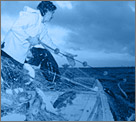A gill net is generally made using a single piece of netting hung between a float line and a lead line. The netting is usually either monofilament netting or multifilament netting. The mesh size, depth, and length of the gill net are determined by the species of fish that you are trying to catch. The gill net mesh size allows a fish of the proper size to fit its head and gills through the net, but not its body. When the fish attempts to pull out of the net, it becomes “gilled” or stuck by its gills.
Shop our Selection of Gill NetsA cast net is a cone shaped net with a weighted perimeter that is thrown by hand. As it travels through the air, the net will open wide and hit the water in a large circle. The weighted edges cause the net to sink and trap fish in the net. An attached line is used to pull the net back with it's catch of fish. Find out about the history of Cast Nets.
Shop our Selection of Cast NetsA seine net is usually made using a single piece of small mesh netting that is hung between a float line and a lead line. A seine is used as a “barrier” to either encircle a school of fish so that they can be retrieved or as a “wall” to move the fish to one end of a pond or lake where they can be retrieved. Seines for Koi ponds can be made of knotless netting in order to protect the fish from being injured while they are being collected. Find out about the history of Seine Nets.
Shop our Selection of Seine Nets
A hoop net is a cylindrical net stretched over a series of hoops. Openings called throats funnel fish into the net where they become trapped and unable to find their way out. The net can be loaded with a bait bag to attract fish.
Shop our Selection of Hoop NetsTrammel nets are made by hanging three pieces of netting to a float line and a lead line. There are two outside pieces of large mesh netting or walls, referred to as walling, and an inside small mesh netting. The size of the walling can range from 7” square to 18” square. The mesh size of the inside netting depends upon the fish you are trying to catch. The fish swim through the first outside mesh or wall, strike the inside netting, pushing it through the other outside mesh, where it forms a pocket and holds the fish. The walling is generally made of nylon netting and the inside netting is made of either monofilament netting or multifilament netting. Find out about the history of Trammel Nets.
Shop our Selection of Trammel Nets

See our Full Selection of All Nets in our Fishing Catalog
